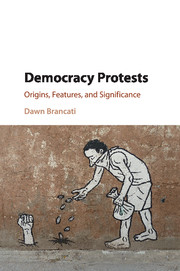Book contents
- Frontmatter
- Dedication
- Contents
- List of Figures
- List of Tables
- Acknowledgments
- 1 Introduction
- 2 Characteristics of Democracy Protests
- 3 Relating Economic Crises to Democracy
- 4 Analyzing the Rise of Democracy Protests
- 5 Analyzing Elections as Trigger Events
- 6 Historical Trends in Government Responses
- 7 Analyzing Political Accommodation
- 8 Historical Trends in Democratization
- 9 Analyzing Democratization
- 10 Conclusion
- Appendix: Data and Measures
- References
- Index
10 - Conclusion
Published online by Cambridge University Press: 05 September 2016
- Frontmatter
- Dedication
- Contents
- List of Figures
- List of Tables
- Acknowledgments
- 1 Introduction
- 2 Characteristics of Democracy Protests
- 3 Relating Economic Crises to Democracy
- 4 Analyzing the Rise of Democracy Protests
- 5 Analyzing Elections as Trigger Events
- 6 Historical Trends in Government Responses
- 7 Analyzing Political Accommodation
- 8 Historical Trends in Democratization
- 9 Analyzing Democratization
- 10 Conclusion
- Appendix: Data and Measures
- References
- Index
Summary
The recent Arab Spring protests in the Middle East and North Africa might lead one to think that democracy protests are rare, massive, spontaneous, unpredictable, and also ineffectual. However, as the preceding analysis makes apparent, democracy protests are in fact rarely any of these things. Democracy protests are not uncommon. While 2011 was a banner year for democracy protests, democracy protests were frequent in earlier periods of history. On average, approximately seventeen democracy protests occurred each year between the end of the Cold War period in 1989 and the first year of the Arab Spring in 2011. They peaked at the beginning and end of this period, and in the first decade of this century around the advent of the Colored Revolutions.
Moreover, not all of the Arab Spring protests were democracy protests. Tunisia's Jasmine Revolution and the Libyan protests were not, since their demands, outside of those seeking the resignation of the government, were limited to economic and social justice-related issues. In other Arab Spring countries where democracy was a major objective, a case can still be made that democracy was not the protesters’ primary demand. In Egypt and Yemen, ousting Mubarak and Saleh was arguably a more predominant concern of the protesters than democracy. In Morocco, where protesters did not desire the king's dethronement, the protesters’ concerns regarding corruption, unemployment, and political freedoms were arguably on par with those of democracy.
Democracy protests do not typically attract participants on the same scale as did many of the Arab Spring protests either. In Egypt, protesters reached an estimated one million people in Tahrir Square alone. In Yemen, the crowds in Sana'a numbered in the hundreds of thousands, and in the capitals of Bahrain and Morocco, they numbered in the tens of thousands. Yet, only about a quarter of democracy protests between 1989 and 2011 included ten thousand participants or more at their single largest rally, and almost a third included less than a thousand people.
Democracy protests are also generally not spontaneous, but rather are carefully planned, typically by either political parties or civil society groups. In fact, two-thirds of all democracy protests that occurred between 1989 and 2011 were organized by one or both of these groups. Even significant elements of the Arab Spring protests were organized by these actors.
- Type
- Chapter
- Information
- Democracy ProtestsOrigins, Features, and Significance, pp. 176 - 181Publisher: Cambridge University PressPrint publication year: 2016



